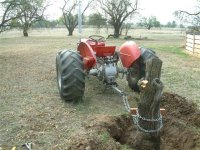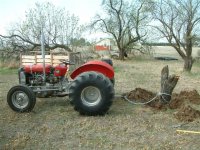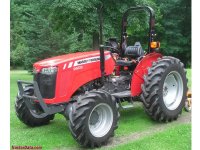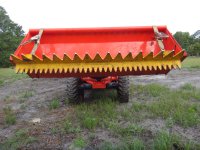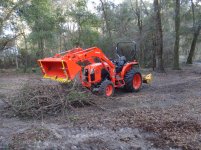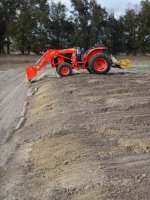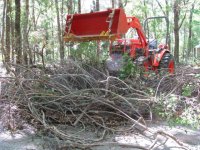ericm979
Super Member
Hi, I have been reading for a while but first post.
We have 20 acres in the California coastal mountains. The land's pretty hilly. Half was cleared a long time ago, the other half is second growth doug fir with some redwoods and (mostly dead) tan oaks. The "cleared" part is brush except for the parts I cleared to meadow. The brush is mostly coyote brush. Soil is sandy with a lot of organic matter in the forested part.
I've been using a B7100HST for 15 years. I run a Merry Mac 4.5" chipper/shredder, 42" rotary mower, use the loader to pull up larger brush, and use the loader to move dirt for the garden and piled leaves on the paved road. Box blade to smooth out places I cleared.
With the land being hilly there's a lot of places too steep to get a tractor in. There's a couple flat acres around the house, a few roads (and more that I need to clear) and about half of the brushy area isn't too steep to operate the B7100 on, especially if I avoid sidehilling.
I'd really like a larger chipper as the current one's just not that effective. I'm thinking a Woodmax 8H or similar. I'll need a bigger tractor to run it. I'd also like to do a lot more clearing of brush and some trees, and the B7100 just can't do that much.
I'm looking at a new Kubota, either a large B or small L. The Woodmax 8H's minimum 19hp would technically be satisfied by a B2650 or L2501 but it seems that more HP would make it more useful. The Ls have a slightly larger turning radius than the Bs. The Ls are heavier which would be good for loader work and stability hauling a 990 lb chipper.
Questions:
-is a B3350 more stable on slopes than an L3301?
-is the lighter weight of a B beneficial on sloped soft soil so it doesn't sink in and tip?
-can the wheels be moved out on B50s or small Ls?
-the R1s on the B7100 have worn, probably due to work on pavement. R4s would handle that much better. Do they also make the track wider than R1s? How about floatation on soft soil?
-how well does the Woodmax 8h handle brush and small stuff?
We have 20 acres in the California coastal mountains. The land's pretty hilly. Half was cleared a long time ago, the other half is second growth doug fir with some redwoods and (mostly dead) tan oaks. The "cleared" part is brush except for the parts I cleared to meadow. The brush is mostly coyote brush. Soil is sandy with a lot of organic matter in the forested part.
I've been using a B7100HST for 15 years. I run a Merry Mac 4.5" chipper/shredder, 42" rotary mower, use the loader to pull up larger brush, and use the loader to move dirt for the garden and piled leaves on the paved road. Box blade to smooth out places I cleared.
With the land being hilly there's a lot of places too steep to get a tractor in. There's a couple flat acres around the house, a few roads (and more that I need to clear) and about half of the brushy area isn't too steep to operate the B7100 on, especially if I avoid sidehilling.
I'd really like a larger chipper as the current one's just not that effective. I'm thinking a Woodmax 8H or similar. I'll need a bigger tractor to run it. I'd also like to do a lot more clearing of brush and some trees, and the B7100 just can't do that much.
I'm looking at a new Kubota, either a large B or small L. The Woodmax 8H's minimum 19hp would technically be satisfied by a B2650 or L2501 but it seems that more HP would make it more useful. The Ls have a slightly larger turning radius than the Bs. The Ls are heavier which would be good for loader work and stability hauling a 990 lb chipper.
Questions:
-is a B3350 more stable on slopes than an L3301?
-is the lighter weight of a B beneficial on sloped soft soil so it doesn't sink in and tip?
-can the wheels be moved out on B50s or small Ls?
-the R1s on the B7100 have worn, probably due to work on pavement. R4s would handle that much better. Do they also make the track wider than R1s? How about floatation on soft soil?
-how well does the Woodmax 8h handle brush and small stuff?
